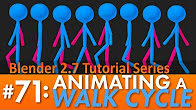In this tutorial you will discover: -The basics of camera tracki. This tutorial will give you a complete beginners introduction to what it is and how to start using it right now. Set a proper range of keyframes for the camera solution.

The solver can get better tracking data from some sections of the video than others. The idea is to use the section of the video that will give blender a better description of the space, based on the difference in the movement of the trackers. Constraint the camera to look at an object. An introduction to camera tracking by Moby Motion. I also show you how to catch shadows, and obscure objects behind things in the scene.
It just takes a little bit of patience. Eliminating the need to switch between programs. Having done so, you can now manipulate the camera using the same tools that are used to transform any object: Roll Press R to enter object rotation mode. The default will be to rotate the camera in its local Z axis (the axis orthogonal to the camera view), which is the definition of a camera “roll”.
Everything depends on it, from rotoscoping to adding lens flares, to more complex things like removing objects from a scene and advanced corner pinning. D camera tracking on basic footage. Some compositing programs, such as Shake, Adobe After Effects, and Discreet Combustion, include two-dimensional motion tracking capabilities.
Two dimensional match moving only tracks features in two-dimensional space, without any concern to camera movement or distortion. An alternative is to use the 2. AE camera tracking is excellent. However, there are limits on the quality of the 3D tracking done from only one camera angle. To get around this, professional tracking setups use multiple cameras recording the same scheme from multiple angles.

Importing footage, tracking and solving the camera motion, rendering, and compositing can now all be done in one smooth workflow, all inside. Adding objects to a scene with camera movement is the only real problem. The ideal result would be my two points being six blender units (or six feet) apart, with the camera scaled at 1. Blender Autotracker addon for Blender 2. Now the camera is tracking your empty.
If you move the object, the parented empty will follow along - which means the camera will track the empty, and the object. However, this is a more flexible setup, since you can now move the empty to control where precisely the camera is tracking your object by moving the empty to, for example, the front. Or if you want a written one, go here. So Setting up Tracking scene, you only ever have to do this once per tracking shot. All it does is add in a camera hooked up to the tracking sclve, add in a floor plane and a cube, set up some basic render layers and comp.
The gun is fake (had people swearing at me for posting a similar one) and so is the target on the wall. Certainly you can use this tutorial on any other footage. But, it has a nice Python API, so you can just do it yourself! This is a script which exports all camera tracking markers of all videos in a blender file to CSV files in a directory called.
To generate the depth map, add a second camera and set the appropriate parameters to match the desired intrinsic. This video gives you a short overview of the basic workflows. It analyses the footage in two steps, hence it might take some time to complete. Camera Tracking in After Effects Step 1.
No comments:
Post a Comment
Note: only a member of this blog may post a comment.